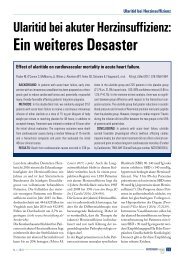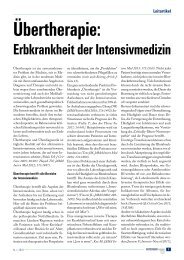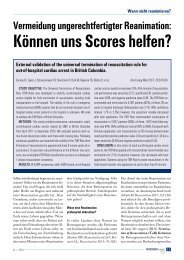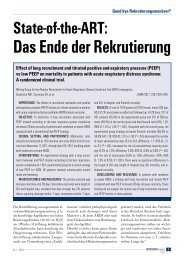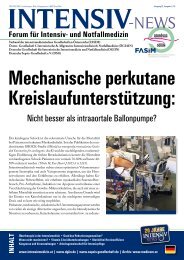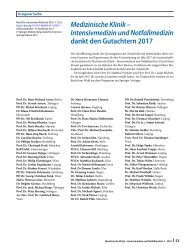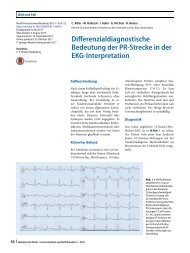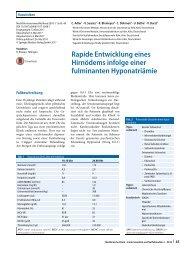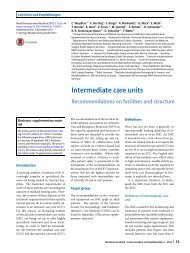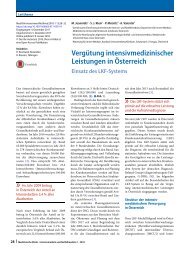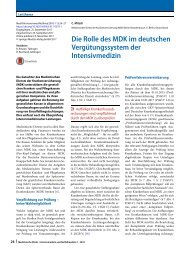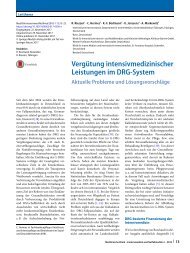09 Die heparininduzierte Thrombozytopenie (HIT II)
Erfolgreiche ePaper selbst erstellen
Machen Sie aus Ihren PDF Publikationen ein blätterbares Flipbook mit unserer einzigartigen Google optimierten e-Paper Software.
Schlussfolgerung<br />
<strong>Die</strong> <strong>HIT</strong> <strong>II</strong> ist auch heute bei dem bereits<br />
erreichten medizinischen Innovationsniveau<br />
ein lebensbedrohliches Krankheitsbild,<br />
was differenzialdiagnostisch bei einer<br />
auftretenden <strong>Thrombozytopenie</strong> regelmäßig<br />
in Erwägung gezogen werden<br />
sollte. Bei <strong>HIT</strong>-<strong>II</strong>-Risikopatienten sollte<br />
durch eine risikoadjustierte Prophylaxe<br />
(s. . Tab. 7)derPatientensicherheitRechnung<br />
getragen werden.<br />
Fazit für die Praxis<br />
<strong>Die</strong> Durchführung einer risikoadjustierten<br />
Prophylaxe bei <strong>HIT</strong>-<strong>II</strong>-Risikopatienten<br />
ist sowohl unter medizinökonomischen<br />
Gesichtspunkten als auch unter<br />
Gründen der Patientensicherheit für die<br />
klinische Praxis empfehlenswert.<br />
Korrespondenzadresse<br />
Prof. Dr. Dipl. Kfm. (FH) R. Riedel<br />
Institut für Medizinökonomie und Medizinische<br />
Versorgungsforschung, Rheinische<br />
Fachhochschule Köln gGmbH<br />
Schaevenstr. 1 b, 50676 Köln, Deutschland<br />
riedel@med-gutachten.koeln<br />
Danksagung. WirdankenProf.Dr.med.Andreas<br />
Greinacher, Leiter der Abteilung Transfusionsmedizin<br />
am Institut für Immunologie und<br />
Transfusionsmedizin der Universitätsmedizin<br />
Greifswald, für die ergänzenden Impulse im Rahmen<br />
der fachlichen Diskussion dieser Arbeit.<br />
Einhaltung ethischer Richtlinien<br />
Interessenkonflikt. A. Koster hielt bis 2015 Vorträge<br />
für die Mitsubishi Tanabe Pharma GmbH. R. Riedel,<br />
A. Schmieder, S. Kim, G. Baumgarten und J. C. Schewe<br />
geben an, dass kein Interessenkonflikt besteht.<br />
<strong>Die</strong>ser Beitrag beinhaltet keine von den Autoren<br />
durchgeführten Studien an Menschen oder Tieren.<br />
Literatur<br />
1. HilbertP,TeumerP,StuttmannR(2008)Thrombembolieprohylaxe<br />
auf deutschen Intensivstationen.<br />
Anaesthesist57(3):242–250<br />
2. Greinacher A, Lubenow N, Hinz P, Ekkernkamp<br />
A (2003) Heparininduzierte <strong>Thrombozytopenie</strong>.<br />
DtschÄrztebl100(34–35):A2220–A2229<br />
3. SakrY(2011)Heparin-inducedthrombocytopenia<br />
intheICU:anoverview.CritCare15(2):1–9<br />
4. Crowther MA, Cook DJ, Meade MO, Griffith<br />
LE, Guyatt GH, Arnold DM, Rabbat CG, Geerts<br />
WH, Warkentin TE (2005) Thrombocytopenia<br />
in medicalsurgical critically ill patients: prevalence,<br />
incidence, and risk factors. J Crit Care<br />
20(4):348–353<br />
5. Baldwin ZK, Spitzer AL, Ng VL, Harken AH<br />
(2008) Contemporary standards for diagnosis and<br />
treatment of heparin-induced thrombocytopenia<br />
(<strong>HIT</strong>).Surgery143(3):305–312<br />
6. Warkentin TE (2005) New approaches to the<br />
diagnosis of heparin-induced thrombocytopenia.<br />
Chest127:35S–45S<br />
7. Geberth S, Nowak R (2014) Antikoagulanzien. In:<br />
Geberth S, Nowak R (Hrsg) Praxis der Dialyse,<br />
2.Aufl.Springer,BerlinHeidelberg,S106<br />
8. Warkentin TE(2003)Heparin-inducedthrombocytopenia.BrJHaematol121:535–555<br />
9. Warkentin TE, Kelton JG (2001) Delayed-onset heparin-inducedthrombocytopeniaandthrombosis.<br />
AnnInternMed135(7):502–506<br />
10. Socher I, Kroll H, Jorks S, Santoso S, Sachs<br />
UJ (2008) Heparin-independent activation of<br />
platelets by heparin-induced thrombocytopenia<br />
antibodies: a common occurence. J Thromb<br />
Haemost6((1):197–200<br />
11. Saugel B, PhillipV, MoessmerG, SchmidRM, Huber<br />
W (2010) Argatroban therapy for heparin-induced<br />
thrombocytopenia in ICU patients with multiple<br />
organ dsyfunction syndrome: a retrospective<br />
study. Crit Care 14(3):1–7 (Erratum in Crit Care<br />
2012;16(2):415)<br />
12. Serebruany MV, Malinin AI, Serebruany VL<br />
(2006) Argatroban, a direct thrombin inhibitor for<br />
heparin-inducedthrombocytopaenia:presentand<br />
future perspectives. Expert Opin Pharmacother<br />
7(1):81–89<br />
13. Warkentin TE (2007) Heparin-induced thrombocytopenia.<br />
Hematol Oncol Clin North Am<br />
21(4):589–607<br />
14. Seleng KS, Selleng S, Greinacher A (2008) <strong>HIT</strong> in<br />
Intensive Care Patients. Semin Thromb Hemost<br />
34(5):425–438<br />
15. Greinacher A, Farner B, Kroll H, Kohlmann T,<br />
Warkentin TE, Eichler P (2005) Clinical features of<br />
heparin-inducedthrombocytopeniaincludingrisk<br />
factors for thrombosis. A retrospective analysis of<br />
408patients.ThrombHaemost94(1):132–135<br />
16. Linkins LA, Warkentin TE (2008) The approach to<br />
heparin-inducedthrombocytopenia.SeminRespir<br />
CritCareMed29(1):66–74<br />
17. Levy JH, Hursting MJ (2007) Heparin-induced<br />
thrombocytopenia, a prothrombotic disease.<br />
HematoloncolClinNorthAm21(2):65–88<br />
18. Coventry DA, Webster NR (2014) Heparininduced<br />
thrombocytopenia and the health<br />
economic analysis of argatroban. Br J Anaesth<br />
112(6):964–967<br />
19. Warkentin TE, Greinacher A (2004) Heparininduced<br />
Thrombocytopenia. In: Warkentin TE,<br />
Greinacher A (Hrsg) Heparin-induced Thrombocytopenia.<br />
Marcel Dekker, New York Basel, S<br />
113–115<br />
20. LeeDH,WarkentinTE(2007)Frequencyofheparininduced<br />
thrombocytopenia. In: Warkentin TE,<br />
Greinacher A (Hrsg) Heparin-induced thrombocytopenia,4.Aufl.InformaHealthcareUSA,NewYork,<br />
S67–116<br />
21. Bakchoul T, Greinacher A (2012) Recent advances<br />
in the diagnosis and treatment of heparininduced<br />
thrombocytopenia. Ther Adv Hematol<br />
3(4):237–251<br />
22. Lubenow N, Hinz P, Thomaschewski S, Lietz T,<br />
Vogler M, Ladwig A, Jünger M, NauckM, Schellong<br />
S, Wander K, Engel G, Ekkernkamp A, Greinacher<br />
A (2010) The severity of trauma determines<br />
the immune response tp PF4/heparin and the<br />
frequencyofheparin-inducedthrombocytopenia.<br />
Blood115(9):1797–1803<br />
23. Prandoni P, Siragusa S, Girolami B, Fabris F (2005)<br />
The incidence of heparin-induced thrombocytopenia<br />
in medical patients treated with lowmolecular-weight<br />
heparin: a prospective cohort<br />
study.Blood106(9):3049–3054<br />
24. Warkentin TE, Greinacher A (2005) Unfractionated<br />
LMWH and the risk of <strong>HIT</strong>: are medical patients<br />
different?Blood106(9):2931–2932<br />
25. JangIK,HurstingsM(2005)Whenheparinspromotethrombosis.Circulation111(20):2671–2683<br />
26. Tsakiris D, Korte W, Fontana P (2013) Heparininduzierte<br />
<strong>Thrombozytopenie</strong> und perioperatives<br />
Management in der antithrombotischen Therapie,<br />
9. ACCP-Guidelines über thrombotische<br />
Behandlung.SchweizMedForum13(36):692–695<br />
27. Kang M, Alahmadi M, Sawh S, Kovacs MJ, Lazo-<br />
Langner A (2015) Fondaparinux for the treatment<br />
of suspected heparin-induced thrombocytopenia:<br />
a propensity score-matched study. Blood<br />
125(6):924–929<br />
28. Mitsubishi Tanabe Pharma GmbH: Fachinformation<br />
Argatra Multidose 100 mg/ml, Konzentrat zur<br />
HerstellungeinerInfusionslösung<br />
29. Alban S (2013) Antikoagulanzien. In: Bartels M<br />
(Hrsg) Gerinnungskompendium: Schnellorientierung,<br />
Befundinterpretation, klinische Konsequenzen,<br />
2. Aufl. Thieme, Stuttgart New York, S 934<br />
(942,950)<br />
30.LoGK,JuhlD,WarkentinTE,SigouinCS,EichlerP,<br />
Greinacher A (2006) Evaluation of pretest clinical<br />
score (4 T’s) for the diagnosis of heparin-induced<br />
thrombocytopeniaintwoclinicalsettings.JThrom<br />
Haemost4(4):759–765<br />
31. Linkins LA, Dans AL, Moores LK, Bona R, Davidson<br />
BL, Schulman S, Crowther M (2012) Treatment<br />
and prevention of heparin-induced thrombocytopenia:<br />
Antithrombotic therapy and prevention<br />
of thrombosis, 9th ed: American College of<br />
Chest Physicians Evidence-Based Clinical Practice<br />
Guidelines.Chest141(Suppl2):e4955–e5305<br />
32. Warkentin TE (2011) How I Diagnose and Manage<br />
<strong>HIT</strong>. Hematology Am Soc Hematol Educ Program<br />
2011:143–149. doi:10.1182/asheducation-2011.<br />
1.143<br />
33. Tesch S (20<strong>09</strong>) <strong>Die</strong> Kosten der Heparininduzierten<br />
<strong>Thrombozytopenie</strong>(<strong>HIT</strong>-<strong>II</strong>)Einepharmako-ökonomische<br />
Analyse. In: Kramer JW, Nitsch KW, Prause<br />
G, Von SchubertA, WeigandA, Winkler J(Hrsg)<strong>Die</strong><br />
Kosten der Heparinindizierten <strong>Thrombozytopenie</strong><br />
(<strong>HIT</strong> <strong>II</strong>). Wismarer Schriften zu Management und<br />
Recht, Bd. 29. Europäischer Hochschulverlag,<br />
Bremen,S81–83<br />
34. Kim SC, Tran N, Schewe JC, Boehm O, Wittmann<br />
M, Graeff I, Hoeft A, Baumgarten G (2015) Safety<br />
and economic considerations of argatroban use<br />
in critically ill patients: a retrospective analysis.<br />
JCardiothoracSurg10(1):1–8<br />
35. Warkentin TE, Greinacher A, Koster A, Lincoff<br />
AM (2008) Treatment and prevention of heparininduced<br />
thrombocytopenia: American college<br />
of chest physicians evidence-based clinical<br />
practice guidelines (8th edition). Chest 133(6<br />
Suppl):340S–380S<br />
36. Alatri A, Armstrong AE, Greinacher A, Koster A,<br />
Kozek-Langenecker SA, Lancé MD, Link A, Nielsen<br />
JD, Sandset PM, Spanjersberg AJ, Spannagl M<br />
(2012) Results of a consensus meeting on the use<br />
of argatroban in patients with heparin-induced<br />
thrombocytopenia requiring antithrombotic<br />
therapy – an European perspective. Thromb Res<br />
129(4):426–433<br />
Medizinische Klinik - Intensivmedizin und Notfallmedizin 4 · 2017 345





